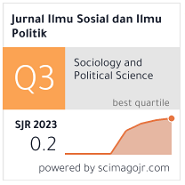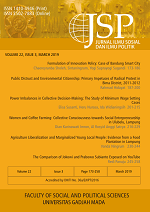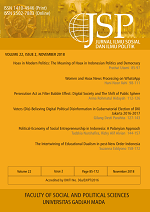Democracy in the Indonesian Digital Public Sphere: Social Network Analysis of Twitter Users' Responses to the Issue of Nationalism Knowledge Test at the Corruption Eradication Commission (TWK-KPK)
Suwandi Sumartias(1), Dwia Aries Tina Pulubuhu(2), Sudarmono Sudarmono(3), Achwan Noorlistyo Adi(4), Eny Ratnasari(5*)
(1) Public Relations Department, Faculty of Communication, Padjadjaran University, Indonesia
(2) Department of Sociology, Hasanudin University, Indoensia
(3) Faculty of Social and Political Science, Sebelas Maret University, Indonesia
(4) Communication Studies Department, Faculty of Social and Political Science, Indonesian University of Informatics and Business, Indonesia
(5) Communication Science Department, Faculty of Social and Political Science, Tidar University, Indonesia
(*) Corresponding Author
Abstract
The mobility restriction during the COVID-19 pandemic did not stop the public from expressing their opinions. Since they could not go on demonstrations, they moved democracy to the digital sphere, such as on Twitter. Previous research has shown that Twitter users in Indonesia use the platform to express political views and opinions on governmental issues. The issue of the Nationalism Knowledge Test (TWK) at the Corruption Eradication Commission (KPK) was a trending topic on Twitter for a while. The issue spurred discussions on Twitter when 75 employees did not pass the KPK-TWK on May 2021. The discussion then stopped for a moment before picking up again during the official dismissal of the employees on 30 September 2021. This article focuses on the social network analysis of the public’s responses to this issue on Twitter. Social network data were collected using Drone Emprit from May to October 2021 and analyzed using Gephi to generate graphical representations of the social networks. The results reveal the structure of the movement was centralized and dynamic. Regarding the dissemination of information, the most central was news media and anti-corruption activists’ accounts. These accounts mobilized the community on Twitter to make a critical social movement. This means that the digital sphere can be an evolution of democracy form and activism, especially in the anti-corruption movement.
Keywords
Full Text:
PDFReferences
Agur, C., & Gan, L. (2021). Actors, Partisan Inclination, and Emotions: An Analysis of Government Shutdown News Stories Shared on Twitter. Social Media + Society, (April-June), 1–12. https://doi. org/10.1177/205630512110088
Bächtiger, A., Dryzek, J. S., Mansbridge, J., & Warren, M. E. (Eds.). (2018). The Oxford handbook of deliberative democracy. Oxford University Press.
Best, M . L ., & M eng, A . (2015). Twitter democracy: Policy versus identity politics in three emerging African democracies. Proceedings of the Seventh International Conference on Information an d Commun ication Te chn ologies and Development, 1–10.
Brundidge, J. (2010). Encountering “difference” in the contemporary public sphere: The contribution of the Internet to the heterogeneity of political discussion networks. Journal of Communication, 60(4), 680–700.
Brynielsson, J., Johansson, F., Jonsson, C., & Westling, A. (2014). Emotion classification of social media posts for estimating people’s reactions to communicated alert messages during crises. Security Informatics, 3(1), 1-11.
Combei, C. R., Farnè, M., Pinto, L., & Giannetti, D. (2020). Populism and Policy Issues: Examining Political Communication on Twitter in Italy 2018-2019. Italian Political Science, 15(2), 223-241.
Cook, T. (2010). Making laws and making news: Media strategies in the US House of Representatives. Brookings Institution Press.
Cheng, M. Y. (2002). Socialising knowledge management: The influence of the opinion leader. Journal of Knowledge Management Practice, 3(3), 76-83.
Dommett, K., & Verovšek, P. J. (2021). Promoting Democracy in the Digital Public Sphere: Applying Theoretical Ideals to Online Political Communication. Javnost-The Public, 28(4), 358-374.
Enli, G. S., & Skogerbø, E. (2013). Personalized campaigns in party-centred politics: Twitter and Facebook as arenas for political communication. Information, Communication & Society, 16(5), 757–774.
Felt, M. (2016). Social media and the social sciences : How researchers employ Big Data analytics. (June), 1–15. https://doi.org/10.1177/2053951716645828
Gaisbauer, F., Pournaki, A., Banisch, S., & Olbrich, E. (2021). Ideological differences in engagement in pub lic deb ate on Twitter. Plos one, 16(3), e0249241.
Golbeck, J. (2013). Analyzing the Social Web. In Analyzing the Social Web. https://doi.org/10.1016/C2012-0-00171-8
Graham, T., & Wright, S. (2014). Discursive equality and everyday talk online: The impact of “superparticipants.” Journal of Computer-Mediated Communication, 19(3), 625–642.
Guarino, S., Trino, N., Celestini, A., Chessa, A., & Riotta, G. (2020). Characterizing networks of propaganda on twitter: a case study. Applied Network Science, 5(1), 1-22.
Hänska, M., & Bauchowitz, S. (2018). #ThisIsACoup: the emergence of an anti-austerity hashtag across Europe’s twittersphere Book section Original citation: Originally published in. In The media and austerity: comparati ve perspectives (pp. 248–261). Routledge.
Helbing, D. (2021). Digital Democracy (Democracy 2.0, 3.0, 4.0). In Next Civilization (pp. 249-268). Springer, Cham.
Himelboim, I., Smith, M. A., Rainie, L ., Shneiderman, B., & Espina, C.(2017). Classifying Twitter Topic-Networks Using Social Network Analysis. https://doi.org/10.1177/2056305117691545
Isa, D., & Himelboim, I. (2018). A Social Networks Approach to Online Social Movement: Social Mediators and Mediated Content in # FreeAJStaff Twitter Network. https://doi.org/10.1177/2056305118760807
Jonh Ugwuanyi, C., & Verlumun Celestine, G. (2019). Social Media as Tools for Political Views Expressed in the Visuals Shared among Social Media Users Igwubuike Innocent Olijo Mr Social Media as Tools for Political Views Expressed in the Visuals Shared among Social Media Users.
Jost, J. T., Barberá, P., Bonneau, R., Langer, M., Metzger, M., Nagler, J., … Tucker, J. A. (2018). How social media facilitates political protest: Information, motivation, and social networks. Political Psychology, 39, 85–118.
Karlsen, R., Steen-Johnsen, K., Wollebæk, D., & Enjolras, B. (2017). Echo chamber and trench w arfare dynamics in online debates. European Journal of Communication, 32(3), 257–273. https:// doi.org/10.1177/0267323117695734
Kaur, M., Verma, R., & Otoo, F. N. K. (2021). Emotions in leader’s crisis communication: Twitter sentiment analysis during COVID-19 outbreak. Journal of Human Behavior in the Social Environment, 31(1-4), 362-372.
Khairiza, F., & Kusumasari, B. (2020). Analyzing political marketing in Indonesia: A palm oil digital campaign case study. Forest and Society, 4(2), 294–309. https://doi. org/10.24259/fs.v4i2.9576
Larrondo,A., Morales I Gras, J., & Terradillos, J. O. (2019). Feminist hashtag activism in spain: Measuring the degree of politicisation of online discourse on #yosítecreo, #hermanayosítecreo, #cuéntalo y #noestássola. Communication and Society. https://doi.org/10.15581/003.32.4.207-221
Lazarsfeld, P. F., Berelson, B., & Gaudet, H. (1948). The People's. Choice.
Liu, B. (2012). Sentiment analysis and opinion mining. Synthesis lectures on human language technologies, 5(1), 1-167.
Lutz, B., & Toit, P. D. (2014). Defining democracy in a digital age: Political support on social media. Springer.
Marin, A., & Wellman, B. (2010). Handbook of Social Network Analysis: an introduction. In Handbook of Social Network Analysis.
Michael, G., & Agur, C. (2018). The bully pulpit, social media, and public opinion: A big data approach. Journal of Information Technology & Politics, 15(3), 262–277.
Monshipouri, M., Whooley, J., & Ibrahim, D. A. (2016). Activism, the Internet, and the struggle for human rights: Youth movements in Tunisia and Egypt. In Information Politics, Protests, and Human Rights in the Digital Age. https://doi. org/10.1017/CBO9781316493120.005
Ottovordemgents chenfeld e, S. (2017). ‘Organizational, professional, personal’: An exploratory study of political journalists and their hybrid brand on Twitter. Journalism, 18(1), 64–80.
Pariser, E. (2011). The filter bubble: What the Internet is hiding from you. Penguin UK.
Pew Research Center. (n.d.). Ideological Placement of Each Source’s Audience. Retrieved December 1, 2021, from https:// www.pewresearch.org/pj_14-10- 21_ mediapolarization-08-2/
Pratama, R. P., & Tjahyanto, A. (2022). The influence of fake accounts on sentiment analysis related to COVID-19 in Indonesia. Procedia Computer Science, 197, 143-150.
Pramono, A., Indriati, R., & Nugroho, A. (2017). Sentiment Analysis Tokoh Politik Pada Twitter. In Prosiding SEMNAS INOTEK (Seminar Nasional Inovasi Teknologi) (Vol. 1, No. 1, pp. 195-200).
Price, V. (1992). Public opinion (Vol. 4). Sage.
Pozzi, F. A., Fersini, E., Messina, E., & Liu, B. (2017). Challenges of sentiment analysis in social networks: an overview. Sentiment analysis in social networks, 1-11.
Recuero, R., Zago, G., & Soares, F. (2019). Using Social Network Analysis and Social Capital to Identify User Roles on Polarized Political Conversations on Twitter. Social Media + Society, (April-June), 1–18. https:// doi.org/10.1177/2056305119848
Ruiz-Soler, J., Curini, L., & Ceron, A. (2019). Commenting on Political Topics Through Twitter: Is European Politics European? Social Media + Society, (October-December), 1–13. https://doi.org/doi. org/10.1177/2056305119890
Russell, F. M., Hendricks, M. A., Choi, H., & Stephens, E. C. (2015). Who sets the news agenda on Twitter? Journalists’ posts during the 2013 US government shutdown. Digital Journalism, 3(6), 925–943.
Sabatier, P. A., & Weible, C. M. (2019). The advocacy coalition framework: Innovations and clarifications. In Theories of the policy process (pp. 189–220). Routledge.
Soares, C. D. M., & Joia, L. A. (2015). The Influence of Social Media on Social Movements: An Exploratory Conceptual Model. 7th International Conference on Electronic Participation (EPart), 9249, 27–38. https://doi. org/10.1007/978-3-319-22500-5_3
Statista. (2021). Twitter users in Indonesia 2025. Retrieved December 1, 2021, from https:// www.statista.com/forecasts/1145550/ twitter-users-in-indonesia
Stier, S., & Steiger, S. (2018). Of activists and gatekeepers: Temporal and structural properties of policy networks on Twitter. https://doi.org/10.1177/1461444817709282
Sumartias, S., Romli, R., Prastowo, F. X. A. A., & Sjuchro, D. W. (2020). Poltical Culture and Virtual Democracy In Indonesia: The Campaign of President’s Election 2018-2019.
Sunstein, C. R. (2001). Designing democracy: What constitutions do. Oxford University Press.
Toha, R. J., & Harish, S. P. (2020). 17 electoral violence in Indonesia 20 years after reformasi. Democracy in Indonesia: From Stagnation to Regression?, 346.
Tumasjan, A., Sprenger, T., Sandner, P., & Welpe, I. (2010). Predicting elections with twitter: What 140 characters reveal about political sentiment. Proceedings of the International AAAI Conference on Web and Social Media, 4(1).
Unsicker, J. (2013). Confronting power: The practice of policy advocacy. Kumarian Press Sterling, VA.
Wang, B . , & Z huang, J. (201 7). Cris is information distribution on Twitter: a co ntent analysis o f tweets d uring Hurricane Sandy. Natural hazards, 89(1), 161-181.
Wojcieszak, M. E., & Mutz, D. C. (2009). Online groups and political discourse: Do online discussion spaces facilitate exposure to political disagreement? Journal of Communication, 59(1), 40–56.
Yao, Q., Li, R. Y. M., Song, L., & Crabbe, M. J. C. (2021). Construction safety knowledge sharing on Twitter: A social network analysis. Safety science, 143, 105411.
Zahra, A. A., Purnomo, E. P., & Kasiwi, A. N. (2020). New democracy in digital era through social media and news online. Humaniora, 11(1), 13-19.
Article Metrics
Refbacks
Copyright (c) 2023 Jurnal Ilmu Sosial dan Ilmu Politik

This work is licensed under a Creative Commons Attribution-NonCommercial-NoDerivatives 4.0 International License.






















